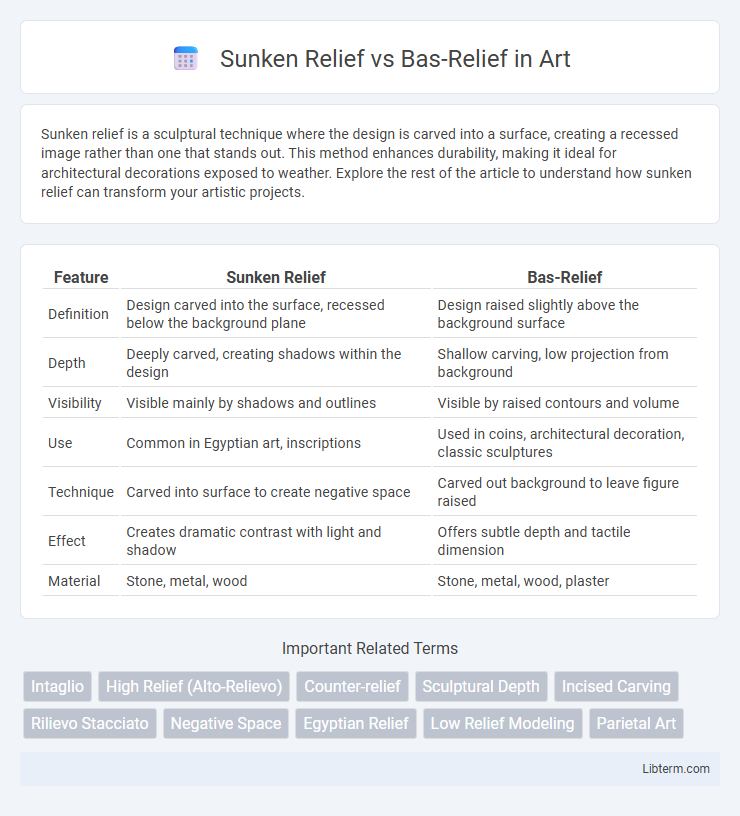Sunken relief is a sculptural technique where the design is carved into a surface, creating a recessed image rather than one that stands out. This method enhances durability, making it ideal for architectural decorations exposed to weather. Explore the rest of the article to understand how sunken relief can transform your artistic projects.
Table of Comparison
| Feature | Sunken Relief | Bas-Relief |
|---|---|---|
| Definition | Design carved into the surface, recessed below the background plane | Design raised slightly above the background surface |
| Depth | Deeply carved, creating shadows within the design | Shallow carving, low projection from background |
| Visibility | Visible mainly by shadows and outlines | Visible by raised contours and volume |
| Use | Common in Egyptian art, inscriptions | Used in coins, architectural decoration, classic sculptures |
| Technique | Carved into surface to create negative space | Carved out background to leave figure raised |
| Effect | Creates dramatic contrast with light and shadow | Offers subtle depth and tactile dimension |
| Material | Stone, metal, wood | Stone, metal, wood, plaster |
Introduction to Relief Sculpture
Relief sculpture involves carving images that project from a flat background, creating a three-dimensional effect on a two-dimensional plane. Sunken relief, or intaglio, features designs carved into the surface, where the image is set below the background level, commonly seen in ancient Egyptian art for its durability and intricate detail. Bas-relief, or low relief, presents figures that slightly protrude from the surface, widely used in Greco-Roman architecture and monuments to create subtle depth and shadow effects.
Definition of Sunken Relief
Sunken relief, or intaglio relief, is a sculptural technique where the design is carved into the surface so that the image is recessed below the surrounding flat area. Unlike bas-relief, where the figures project slightly outward, sunken relief emphasizes depth by cutting into the material, often used to create intricate and durable images on stone surfaces. This method is prominent in ancient Egyptian art, where it allowed shadow play to enhance the contours of the carved figures.
Definition of Bas-Relief
Bas-relief, also known as low relief, is a sculptural technique where figures are slightly raised from the background, creating shallow depth while maintaining a flat overall surface. This contrast with sunken relief, where the image is carved into the surface, resulting in an engraved appearance below the background plane. Bas-relief is commonly used in architectural decorations and coins due to its subtle dimensional effect and durability.
Historical Origins and Context
Sunken relief, originating in ancient Egyptian art, involves carving images into a flat surface so the design is recessed below the surrounding area, often used for hieroglyphs and royal iconography. Bas-relief, with roots in Mesopotamian and classical Greek cultures, features sculpted elements that project slightly from a flat background, allowing for more detailed, three-dimensional representations of figures and narratives. Both techniques served distinct cultural and religious purposes, reflecting the aesthetic priorities and material constraints of their respective civilizations.
Key Artistic Techniques
Sunken relief involves carving the design into the surface so that the image is recessed below the surrounding plane, creating shadows that enhance depth perception. Bas-relief, or low relief, features shallow projecting elements that stand out slightly from the background, emphasizing contours with subtle modeling. Key artistic techniques for sunken relief include precise incision and controlled depth to manipulate light, while bas-relief relies on surface modeling and gradation of relief to convey form and texture.
Visual Differences Explained
Sunken relief features designs carved into the surface, creating recessed images that remain below the background plane, which enhances shadows and depth perception. Bas-relief, or low relief, has raised elements that extend slightly above the surface, allowing light to highlight the protruding forms while maintaining a subtle dimensionality. The primary visual difference lies in sunken relief's indented contours versus bas-relief's elevated shapes, influencing how light interacts with the artwork and affects its overall visual impact.
Notable Examples in Art History
Sunken relief, exemplified by the ancient Egyptian reliefs at the Temple of Karnak, allows figures to be carved into the surface, creating depth by recessing the background. Bas-relief, seen in the Parthenon friezes, features shallow carvings that project slightly from a flat background, enhancing narrative detail and spatial clarity. Both techniques have been crucial in conveying historical and religious stories through architectural sculpture.
Cultural Significance and Uses
Sunken relief features images carved into the surface, deeply incised below the plane, prominently used in ancient Egyptian temples to depict deities and pharaohs, reinforcing religious authority and cultural narratives. Bas-relief, where figures slightly project from the background, gained prominence in Greco-Roman art and Renaissance monuments, symbolizing humanism and historical storytelling in public spaces and architectural decoration. Both techniques serve as critical mediums for preserving cultural identity and conveying societal values through visual hieroglyphs and sculptural storytelling.
Preservation and Restoration Challenges
Sunken relief, characterized by images carved below the surface, often offers better protection against erosion and physical damage compared to bas-relief, where figures project outward and are more susceptible to breakage. Preservation of sunken relief requires careful monitoring of surface wear and environmental impacts that can obscure the incised details, while bas-relief restoration faces challenges such as reattaching or reconstructing protruding elements vulnerable to chipping. Both forms demand specialized techniques, but bas-relief's prominence increases restoration complexity due to its higher exposure to mechanical and climatic deterioration.
Summary: Choosing Between Sunken Relief and Bas-Relief
Sunken relief features designs carved below the surface, creating shadows that enhance depth, while bas-relief projects slightly from the background, offering subtle three-dimensionality. Choosing between sunken relief and bas-relief depends on the desired visual impact, with sunken relief providing sharp contrasts suitable for outdoor monuments and bas-relief favoring gentle modeling ideal for decorative panels. Artists and architects prioritize sunken relief for durability and clarity under natural light, whereas bas-relief is preferred for detailed narrative scenes requiring softer shading.
Sunken Relief Infographic

 libterm.com
libterm.com